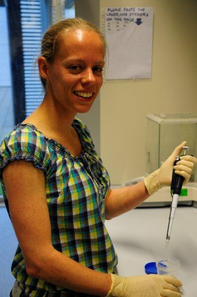Manipulation of drops with electrowetting:
From morphological transitions to microfluidics
Promotion date: March 26.
Promotor: Prof.dr. Frieder Mugele
| Oil recovery can be considered as an applied two-phase flow microfluidics problem, in which oil and water flow through a network of microscopic pore throats in porous rock. With current technology only about 50% of the oil present in the pore space can be recovered, while the other part remains in the reservoir due to heterogeneity in the wettability and structure of the rock. Various scientific aspects, related to the mobilization and subsequent removal of small liquid volumes interacting with heterogeneous solid walls, are addressed. In Enhanced Oil Recovery, the low salinity water flooding method is thought to improve oil recovery via a wettability alteration of the rock. However, the composition of the injection water also influences the adsorption of amphiphilic species onto the oil-water interface. This interfacial adsorption is studied. Next, the shape and position of drops interacting with solid walls is studied in two different model systems. The case of a drop confined between a sphere and a plane is discussed, as is the case of a drop in contact with a cylindrical substrate, i.e., a fiber. Electrowetting is used as a method to tune the wettability of these substrates. Morphological transitions are observed upon variations in the wettability. Finally, drops confined between the top and bottom walls of a microfluidic channel are considered. Electrodes are incorporated in the microchannel wall to create a local (electro)wetting defect with tunable strength, and the balance between retaining and driving forces is studied. A simple model, comparing the maximum trapping force and the drag force, provides excellent predictions about whether a drop is released from the pinning site. In addition, the tunable electrical traps can be used as a new tool in continuous-flow microfluidics. Combining the individual drop control achieved using electrical actuation with the high throughput of channel-based microfluidics, enables several drop manipulations that are important for many lab-on-a-chip applications, such as on-demand drop trapping and release, guiding, and high-speed sorting. |
Was your research application driven or more fundamental in nature?
Different routes were followed during this thesis research, all inspired by enhanced oil recovery issues as the project was part of a bigger project in collaboration with British Petroleum. Next to our Physics of Complex Fluids (PCF) Group, a German and a Danish research group were also involved in this project.
Ten percent oil recovery enhancement might result in five to ten years extra oil usage on a worldwide scale. Although the project was application driven we investigated some fundamental aspects related to the wetting of structured surfaces. As a simple model for rock pores we considered a drop present in the gap in between a sphere and a plane, and also compared this to drops interacting with a fiber. We studied different morphology transitions, as these might result in additional oil recovery.
Lab-on-a-Chip devices may benefit from some of the findings in this thesis as well, which was a nice side effect of this research. Creating local electrostatic potential wells (‘defects’) by using electrodes in microfluidic channels, could be a very effective method to study individual cells or molecules in continuous flows. For example circulating tumor cells have to be sorted out individually - but under high throughput conditions - for bringing innovative diagnostic or treatment methods more within reach.
Were there some special moments you recall during the PhD process?
Successfully creating these ‘wetting defects’ in a controllable way in order to model some characteristics in oil recovery, was an important breakthrough. Especially as this feature was altogether very promising in innovative Lab-on-a-Chip devices.
Did you publish some nice articles?
Two articles appeared in Langmuir, as well as in Lab-on-a-Chip. One article was published by Soft Matter as well, and one will be submitted to another journal.
In what way did you ‘evolve’ as a scientist and researcher during the PhD period?
I liked to perform experimental work during my master’s thesis project already, and I discovered this aspect of research suits me very well still. Though I contributed to some publications as a student already, I improved in presenting a clear storyline and message, and I am more confident now doing so.
What are your future plans?
I would like to stay in academics. First of all, I am going to work as a postdoc within the Physics of Complex Fluids Group, studying the use of electrowetting to influence dropwise condensation. Thereafter, I will look for a research position, for example in France or the United States. I have previously been in Boston during my studies. I think that would for example be a really nice option to repeat.
Did you feel part of the Mesa+ institute while working on your PhD project?
In sample preparation I benefited a lot from the expertise brought in by our cleanroom technician. Not much collaboration links existed within Mesa+ concerning my research, the more so with the group from Germany.
My professor Frieder Mugele organized a minisymposium the day after my thesis defense, which was on the same day as the defense of my sister Jolet de Ruiter. The symposium was on ‘Smart drops and surfaces’. The international experts from Paris, Liege, and Boston –who were also present at our defenses - had some inspiring talks. These were also attended by many Mesa+ colleagues.

